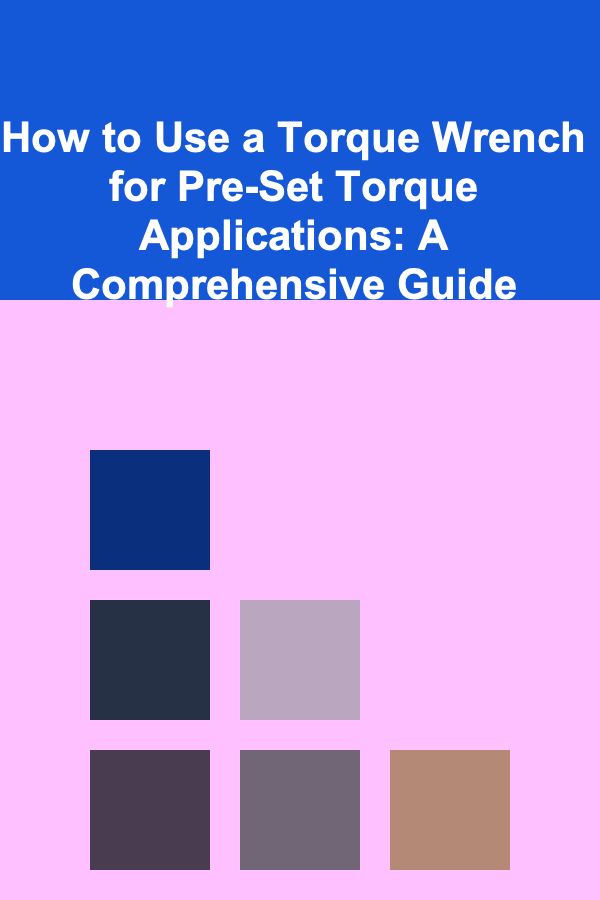
How to Use a Torque Wrench for Pre-Set Torque Applications: A Comprehensive Guide
ebook include PDF & Audio bundle (Micro Guide)
$12.99$7.99
Limited Time Offer! Order within the next:

Applying the correct torque to fasteners, such as nuts and bolts, is critical in numerous applications across various industries. Whether you're assembling machinery, working on automotive repairs, or constructing infrastructure, achieving the specified torque ensures the integrity and longevity of the assembled components. Under-torquing can lead to loosening and eventual failure, while over-torquing can damage the fastener itself or the materials being joined. A torque wrench is the indispensable tool for achieving accurate and repeatable torque values. This guide provides a comprehensive overview of how to effectively use a torque wrench for pre-set torque applications, covering different types, selection criteria, calibration, operating procedures, and essential safety considerations.
Understanding Torque and its Importance
Torque, often referred to as tightening torque, is a rotational force that causes an object to rotate. It's measured in units like Newton-meters (Nm) or foot-pounds (ft-lbs). Applying the correct torque stretches the bolt or stud to a specific tension, which generates a clamping force between the joined materials. This clamping force is what holds the assembly together securely.
The importance of applying the correct torque cannot be overstated:
- Structural Integrity: Proper torque ensures the assembly can withstand intended loads and stresses without loosening or failing.
- Safety: Incorrect torque can lead to catastrophic failures, especially in safety-critical applications like aircraft assembly or bridge construction.
- Performance: In many mechanical systems, achieving optimal performance relies on properly torqued components. For example, engine head bolts must be torqued correctly to maintain proper compression and prevent leaks.
- Longevity: Correct torque minimizes the risk of premature wear and tear, extending the lifespan of the assembly.
- Warranty Compliance: Many manufacturers require specific torque values to be used during assembly to maintain warranty validity.
Types of Torque Wrenches
Several types of torque wrenches are available, each with its own advantages and disadvantages. Understanding these differences is crucial for selecting the right tool for the job.
Click-Type Torque Wrenches
Click-type torque wrenches are arguably the most common and widely used type. They feature an internal mechanism that "clicks" or releases slightly when the pre-set torque value is reached. This audible and tactile feedback indicates that the desired torque has been achieved.
Advantages:
- Ease of Use: Relatively simple to set and use, making them suitable for both professionals and DIY enthusiasts.
- Audible and Tactile Feedback: The distinct click provides clear confirmation that the target torque has been reached.
- Versatility: Available in a wide range of torque ranges and drive sizes.
- Cost-Effective: Generally more affordable than other types of torque wrenches.
Disadvantages:
- Potential for Overtorquing: If the user continues to apply force after hearing the click, overtorquing can occur.
- Accuracy Can Drift: Require regular calibration to maintain accuracy. Leaving them set at a high torque value for extended periods can affect calibration.
- Reliance on Senses: The user must be able to hear and feel the click, which can be difficult in noisy environments or with thick gloves.
Beam-Type Torque Wrenches
Beam-type torque wrenches are the simplest type, consisting of a long beam with a scale that indicates the applied torque. A pointer attached to the wrench head moves along the scale as torque is applied.
Advantages:
- Simple Design: Highly durable and less prone to mechanical failure.
- Relatively Inexpensive: Generally the most affordable type of torque wrench.
- Visual Indication: Provides a continuous visual reading of the applied torque.
Disadvantages:
- Difficult to Use in Tight Spaces: The long beam can be cumbersome in confined areas.
- Requires Direct Line of Sight: The user must have a clear view of the scale while applying torque.
- Less Precise: Reliance on visual estimation can lead to less accurate results.
- Sensitive to Bending: If the beam is bent, the accuracy will be affected.
Digital Torque Wrenches
Digital torque wrenches feature an electronic sensor and display that provides a numerical reading of the applied torque. They often include features like pre-set alerts, data logging, and multiple unit conversions.
Advantages:
- High Accuracy: Offers the highest level of accuracy compared to other types of torque wrenches.
- Digital Display: Provides a clear and precise reading of the torque value.
- Multiple Units: Can display torque in various units (Nm, ft-lbs, in-lbs).
- Data Logging: Some models can store torque readings for documentation and analysis.
- Audible and Visual Alerts: Often includes alerts to indicate when the target torque is reached or exceeded.
Disadvantages:
- Higher Cost: The most expensive type of torque wrench.
- Reliance on Batteries: Requires batteries to operate, which can be a concern in some situations.
- More Complex: May require more training to use effectively.
- Susceptible to Damage: More vulnerable to damage from impacts or harsh environments.
Slipping Torque Wrenches
Slipping torque wrenches, also known as cam-over torque wrenches, are designed to automatically slip or disengage when the pre-set torque value is reached. This prevents overtorquing, making them ideal for applications where precise torque control is crucial.
Advantages:
- Prevents Overtorquing: Automatically prevents overtorquing, ensuring consistent and accurate results.
- Ideal for Production Environments: Well-suited for repetitive torque applications in manufacturing or assembly lines.
- Reduced Operator Error: Minimizes the risk of operator error due to over-application of force.
Disadvantages:
- Limited Torque Range: Typically available for specific torque ranges, requiring different wrenches for different applications.
- Less Versatile: Not as versatile as other types of torque wrenches for general use.
- Calibration Sensitivity: Requires precise calibration and maintenance to ensure accurate slipping.
Selecting the Right Torque Wrench
Choosing the appropriate torque wrench is essential for achieving accurate and reliable results. Consider the following factors when making your selection:
Torque Range
The most important factor is the torque range required for your application. Select a torque wrench whose range encompasses the specified torque value. It's generally recommended to choose a wrench where the target torque falls within the middle of its range. Using a wrench at the very bottom or top of its range can reduce accuracy.
Drive Size
Torque wrenches come in various drive sizes (e.g., 1/4", 3/8", 1/2", 3/4", 1"). The drive size must match the size of the sockets or attachments you'll be using. Using adapters can affect accuracy, so it's best to choose a wrench with the appropriate drive size whenever possible.
Application
Consider the specific application for which you'll be using the torque wrench. For example, if you're working in a confined space, a shorter beam-type or digital torque wrench might be more suitable. For high-volume production environments, a slipping torque wrench could be the best option.
Accuracy Requirements
Determine the level of accuracy required for your application. Digital torque wrenches typically offer the highest accuracy, while beam-type wrenches are generally less precise. Consider the tolerance specified for the torque value. If the tolerance is tight, a more accurate torque wrench is essential.
Budget
Torque wrenches range in price from relatively inexpensive beam-type wrenches to more costly digital models. Balance your budget with the required accuracy, features, and durability.
Brand Reputation
Choose a torque wrench from a reputable brand known for quality and reliability. Look for brands that offer calibration services and warranties.
Calibration and Maintenance
Torque wrenches are precision instruments that require regular calibration to maintain accuracy. Calibration involves comparing the wrench's output to a known standard and adjusting it to meet specified tolerances. The frequency of calibration depends on the usage and application, but a general guideline is to calibrate:
- Every 3 to 6 months for frequent use.
- Annually for occasional use.
- After any significant impact or damage.
Most manufacturers offer calibration services, or you can use a third-party calibration lab. When calibrating, ensure that the process is traceable to national or international standards.
In addition to calibration, proper maintenance is essential for prolonging the life of your torque wrench:
- Clean the wrench regularly with a clean, dry cloth.
- Store the wrench in a protective case or storage tube.
- Loosen the adjustment on click-type wrenches to the lowest setting when not in use. This relieves tension on the internal spring.
- Avoid dropping or subjecting the wrench to excessive force.
- Do not use the torque wrench as a breaker bar or for loosening fasteners.
- Inspect the wrench for any signs of damage, such as cracks or bends.
Step-by-Step Guide to Using a Torque Wrench for Pre-Set Torque Applications
This section provides a detailed, step-by-step guide on how to use a torque wrench effectively and safely for pre-set torque applications, focusing on click-type wrenches as they are the most common. While specific steps may vary slightly depending on the wrench type, the general principles remain the same.
1. Gather Necessary Tools and Materials
- Torque Wrench: Select the appropriate type and torque range for the application.
- Socket: Choose the correct size and type socket for the fastener. Ensure the socket is in good condition and fits snugly.
- Fastener: The nut or bolt to be torqued. Verify its size and thread pitch.
- Lubricant (if required): Some applications require lubrication of the threads before torquing. Consult the manufacturer's specifications.
- Manufacturer's Specifications: The specified torque value for the fastener. This information is crucial and should be readily available.
- Protective Gear: Safety glasses and gloves are recommended.
2. Prepare the Fastener and Joint
- Clean the Threads: Ensure the threads of the bolt and nut are clean and free from debris, rust, or dirt. Use a wire brush or thread chaser if necessary.
- Lubricate (if required): If specified by the manufacturer, apply a thin layer of lubricant to the threads. Using the wrong lubricant or applying too much can significantly affect the achieved torque. Different lubricants have different torque coefficients, so using the wrong one will lead to inaccurate results.
- Ensure Proper Alignment: Make sure the bolt and nut are properly aligned and seated before applying torque. Cross-threading can damage the threads and compromise the joint's integrity.
3. Set the Torque Wrench to the Specified Value
This step is critical for achieving the desired torque.
For Click-Type Torque Wrenches:
- Locate the Adjustment Mechanism: This is typically a handle or knob at the end of the wrench. Some wrenches have a locking mechanism that needs to be released before adjustment.
- Adjust the Torque Value: Rotate the handle or knob to set the desired torque value. Most wrenches have a scale that indicates the torque setting. Some scales have both primary and secondary units (e.g., ft-lbs and Nm). Be sure to use the correct units. Pay close attention to the scale and ensure you are setting the correct value. Some scales can be difficult to read.
- Lock the Setting (if applicable): Some wrenches have a locking mechanism to prevent accidental changes to the torque setting. Engage the locking mechanism after setting the torque value.
For Digital Torque Wrenches:
- Turn on the Wrench: Power on the wrench and wait for it to initialize.
- Select the Units: Choose the appropriate units of measurement (e.g., Nm, ft-lbs, in-lbs).
- Enter the Target Torque Value: Use the buttons or keypad to enter the desired torque value.
- Set the Mode (if applicable): Some digital wrenches have different modes, such as peak hold or track mode. Select the appropriate mode for your application. Peak hold captures the maximum torque value achieved, while track mode displays the real-time torque being applied.
Important Considerations:
- Double-Check the Setting: Always double-check the torque setting before applying torque to ensure it's correct.
- Use the Correct Units: Pay close attention to the units of measurement and ensure they match the manufacturer's specifications.
- Consider Conversion Factors: If the torque value is specified in different units than your wrench's scale, use the appropriate conversion factor.
4. Apply Torque to the Fastener
This is the most crucial step in the process. Consistency and proper technique are key to achieving accurate results.
- Position the Socket: Place the socket securely onto the nut or bolt head. Ensure the socket is fully engaged and properly seated.
- Apply Force Smoothly and Steadily: Grip the torque wrench firmly and apply force in a smooth and controlled manner. Avoid jerky or sudden movements. Pull the wrench in a straight line, perpendicular to the fastener. Apply force gradually to avoid overshooting the target torque.
- Listen and Feel for the Click (Click-Type Wrenches): When the pre-set torque value is reached, the wrench will emit a distinct "click" and you will feel a slight release. Stop applying force immediately when you hear and feel the click. Continuing to apply force after the click will result in overtorquing.
- Watch the Display (Digital Torque Wrenches): Monitor the digital display as you apply torque. Stop applying force when the display reaches the target torque value. Some digital wrenches have audible and visual alerts that indicate when the target torque has been reached.
- Observe the Beam (Beam-Type Wrenches): Carefully observe the pointer on the beam as you apply force. Stop applying force when the pointer reaches the desired torque value on the scale. Ensure you have a clear line of sight to the scale and pointer.
- Allow the Wrench to Slip (Slipping Torque Wrenches): Continue applying force until the wrench slips or disengages. The slipping action indicates that the pre-set torque value has been reached.
Important Considerations:
- Maintain a Perpendicular Angle: Keep the torque wrench perpendicular to the fastener to ensure accurate torque application. Using the wrench at an angle can affect the leverage and result in inaccurate readings.
- Avoid Extensions: Avoid using extensions on the torque wrench handle, as this can affect the accuracy of the torque reading. If an extension is necessary, calculate the adjusted torque value.
- Do Not Jerk: Apply force smoothly and steadily to avoid overtorquing.
- One Continuous Motion: Apply the torque in one continuous motion, without pausing or stopping.
5. Verify the Torque (Optional)
In some critical applications, it may be necessary to verify the torque after the initial application.
- Re-Apply Torque: Set the torque wrench to the same value and re-apply torque to the fastener. If the wrench clicks or slips immediately, the fastener is properly torqued.
- Use a Torque Tester: For more precise verification, use a torque tester to measure the actual torque applied to the fastener.
6. Document the Torque Application
For quality control and traceability purposes, it's good practice to document the torque application.
- Record the Torque Value: Note the specified torque value used.
- Record the Date and Time: Document the date and time of the torque application.
- Record the Fastener Identification: Identify the specific fastener that was torqued.
- Record the Operator's Name: Note the name of the person who applied the torque.
- Record the Torque Wrench Information: Include the torque wrench's model number, serial number, and calibration date.
Safety Considerations
Using a torque wrench safely is paramount to preventing injuries and damage to equipment.
- Wear Safety Glasses: Always wear safety glasses to protect your eyes from flying debris.
- Wear Gloves: Wear gloves to improve grip and protect your hands from sharp edges.
- Use the Correct Size Socket: Using the wrong size socket can damage the fastener or the torque wrench.
- Inspect the Torque Wrench: Before each use, inspect the torque wrench for any signs of damage.
- Do Not Exceed the Torque Range: Never exceed the torque range of the wrench.
- Apply Force Carefully: Apply force smoothly and steadily to avoid injury.
- Avoid Working in Unstable Positions: Ensure you have a stable footing before applying torque.
- Follow Manufacturer's Instructions: Always follow the manufacturer's instructions for the torque wrench and the fastener.
Troubleshooting Common Issues
Even with careful preparation and execution, issues can arise when using a torque wrench. Here are some common problems and their potential solutions:
- Torque Wrench Not Clicking:
- Check the Torque Setting: Ensure the torque setting is properly adjusted.
- Check for Obstructions: Make sure there are no obstructions preventing the wrench from clicking.
- Check for Damage: Inspect the wrench for any signs of damage.
- Recalibrate: The wrench may need to be recalibrated.
- Fastener Stripping:
- Check the Torque Setting: Ensure the torque setting is not too high.
- Check the Threads: Inspect the threads for damage.
- Use a New Fastener: Replace the stripped fastener with a new one.
- Lubricate Properly: Ensure proper lubrication if required.
- Inconsistent Torque Readings:
- Check Calibration: The wrench may need to be recalibrated.
- Check Technique: Ensure you are applying force smoothly and steadily.
- Check for Joint Irregularities: Look for irregularities in the joint surface that may be affecting the torque reading.
- Digital Torque Wrench Malfunctioning:
- Check Batteries: Ensure the batteries are properly installed and charged.
- Check Connections: Inspect the connections for any loose or damaged wires.
- Consult the Manual: Refer to the user manual for troubleshooting steps.
Advanced Techniques and Considerations
For more complex applications or when dealing with specific materials, consider these advanced techniques and considerations:
Torque-Angle Method
The torque-angle method, also known as torque-turn tightening, involves first applying a pre-determined torque and then further tightening the fastener by a specified angle. This method is often used for critical applications where precise bolt stretch is required, such as engine head bolts. The angle is typically measured in degrees. The torque-angle method is more accurate than simply applying a specific torque value, as it accounts for variations in thread friction and bolt preload.
Friction Considerations
Friction plays a significant role in torque application. Variations in friction between the threads and the fastener head can significantly affect the achieved clamping force. Using the correct lubricant, ensuring clean threads, and accounting for surface finishes are all important considerations.
Torque Coefficient
The torque coefficient (K-factor) is a dimensionless value that represents the relationship between torque, bolt tension, and bolt diameter. It is used to calculate the required torque for a specific application, taking into account the friction between the threads and the bearing surface. Different lubricants and surface finishes have different K-factors. Consult engineering handbooks or online resources for appropriate K-factors for different materials and lubricants.
Sequential Torquing
For multi-bolt assemblies, such as cylinder heads or flanges, sequential torquing is often required. This involves tightening the bolts in a specific sequence to ensure even distribution of clamping force. The sequence is typically specified by the manufacturer and is designed to prevent distortion or warping of the assembly.
Impact Wrenches and Torque
Impact wrenches are designed for loosening and tightening fasteners quickly and efficiently, but they are generally not suitable for achieving precise torque values. Using an impact wrench to torque a fastener can easily result in overtorquing or undertorquing. If you need to achieve a specific torque value, always use a calibrated torque wrench.
Conclusion
Using a torque wrench correctly is crucial for ensuring the structural integrity, safety, and longevity of assembled components. By understanding the different types of torque wrenches, selecting the appropriate tool for the application, properly calibrating and maintaining the wrench, and following the step-by-step guide outlined in this document, you can achieve accurate and reliable torque values. Remember to always prioritize safety and consult the manufacturer's specifications for the fastener and the torque wrench. With proper knowledge and technique, you can confidently use a torque wrench to achieve pre-set torque applications in a wide range of industries and situations.

How to Craft a Time Capsule Journal for Reflection
Read More
How to Renovate Your Home to Fit Your Growing Family's Needs
Read More
Navigating Regulatory Changes in Healthcare Administration
Read More
The Cloud Engineer's Playbook: Designing and Managing Cloud Solutions
Read More
The Role of Internships in Securing Full-Time Employment
Read More
How To Draw Fabric and Drapery
Read MoreOther Products

How to Craft a Time Capsule Journal for Reflection
Read More
How to Renovate Your Home to Fit Your Growing Family's Needs
Read More
Navigating Regulatory Changes in Healthcare Administration
Read More
The Cloud Engineer's Playbook: Designing and Managing Cloud Solutions
Read More
The Role of Internships in Securing Full-Time Employment
Read More